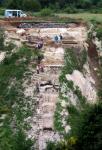Summary (English)
Valle Giumentina is an open, early and middle Paleolithic site, briefly excavated in the 1950s by Prof. Radmilli of Pisa University and the geologist J. Demangeot. Seven archaeological layers were exposed within a lacustrine context, on the side of a deep ravine that had eroded the Pleistocene deposits to a depth of 25 m.
As part of a five-year programme run by the École Française de Rome (2012-2016), multi-disciplinary research has been taking place with the aim of defining the dating of the stratigraphy, determine the nature of the lithic industry present and the type of occupation on the site.
During the first season (2012), a core sample was taken from the quaternary deposits to a depth of 45 m, and the first blackish paleo-soil, located at over 3.5 m in depth, was excavated over an area of 1 m2. The first lithic industry in a stratigraphic context of the new research programme was recovered. The section was cleaned down to a depth of 7 m. The second season (2013) had three objectives: the excavation of the first paleo-soil over an extensive area (platform of over 40 m2), the dating of the stratigraphy and collection of paleo-environmental data from the section (to a depth of about 16 m), and the definition of the limestone basin of Valle Giumentina and of the geometry of the deposits using resistivity.
In 2014, the main season took place between 18th May and the 1st July. The geo-morphological survey was carried out in August. The archaeological and geo-chronological research continued that of the previous season.
The excavation of the first paleo-soil (levels ALB and LDP), situated between 3.80 and 4.30 m in depth, was extended. Level ALB was explored over an area of about 48 m2, and level LDP over a surface of 22 m2. The excavations brought to light 118 flint artefacts, 43 faunal remains, and 28 charcoal fragments. The quantimeters inserted last year to take readings for OSL (optical stimulated luminescence) dating were removed at the beginning of the season. Section VV1 was extended by a metre (to 17 m in depth), in order to reach a level containing volcanic deposits identified during the core sample analysis. Samples were collected for Ar/Ar dating, and 30 sediment samples were taken for the malacological study. The sieving of the sediments began on site and will be completed in the laboratory at Meudon. The fieldwork undertaken in August had different objectives. Its main aim was the completion of the photographic survey of the Giumentina Valley, covering all of the sector surrounding the archaeological site as far as the confluence with the Santo Spirito/San Bartolomeo canyon. Photogrammetry will be used to convert the over 1000 photographs into a detailed 3D digital model of the valley.
- Elisa Nicoud - École française de Rome
Director
Team
- Christelle Lahaye – Maître de Conférence, Université Bordeaux 3 Michel de Montaigne, UMR 5060 Institut de Recherche sur les Archéomatériaux, Bordeaux
- Marion Hernandez - Max Plank Institut, Leipzig
- Sébastien Nomade - CEA Gif-sur-Yvette
- Daniele Aureli - Università di Siena - UMR 7041 ArScAn-AnTET
- Marina Pagli - Université Paris Nanterre - UMR 7041 ArScAn-AnTET
- Biagio Giaccio - Consiglio nazionale della Ricerca, Roma
- Catherine Kuzucuoglu- CNRS
- Christine Chaussé - Institut national de recherches archéologiques préventives (INRAP)
- Clément Virmeux- CNRS, UMR 8591
- Giovanni Boschian - Università di Pisa
- Jean-Philippe Degeai - CNRS
- Silvano Agostini - Soprintendenza per i Beni Archeologici dell’Abruzzo
- Valentina Villa - Università Paris 1/Pisa/Ecole française de Rome
- Vincent Robert- CNRS, UMR 8591
- Maria Adelaide Rossi - Soprintendenza per i Beni archeologici dell’Abruzzo, Chieti
- Paul Mazza - Università degli Studi di Firenze
- Fabio Fusco
- Christelle Lahaye – Maître de Conférence, Université Bordeaux 3 Michel de Montaigne, UMR 5060 Institut de Recherche sur les Archéomatériaux, Bordeaux
- Marion Hernandez – Ingénieur, CNRS, UMR 5060 IRAMAT Institut de Recherche sur les Archéomatériaux, Bordeaux.
- Norbert Mercier – Directeur de Recherche, CNRS, UMR 5060 IRAMAT Institut de Recherche sur les Archéomatériaux, Bordeaux
- Nicole Limondin-Lozouet – CNRS, UMR 8991 LGP
- Alison Pereira - Muséum nationale d’Histoire naturelle/Ferrara/EFR/CEA
- Andrea Zupancich - Doctorant, Tel Aviv University, Università di Roma – La Sapienza, Dipartimento di Scienze dell’Antichità, Laboratorio di Analisi Tecnologica e Funzionale dei Manufatti Pre- e Protostorici
- Cristina Lemorini - Università di Roma – La Sapienza, Dipartimento di Scienze dell’Antichità, Laboratorio di Analisi Tecnologica e Funzionale dei Manufatti Pre- e Protostorici.
Research Body
- CEA, Gif-sur-Yvette
- Centre national de la recherche scientifique
- Institut national de recherches archéologiques préventives
- Soprintendenza per i Beni archeologici dell’Abruzzo
- UMR 5060 Institut de recherche sur les archéomatériaux, Centre de Recherche en Physique appliquée à l'Archéologie, Pessac
- UMR 5140 Archéologie des sociétés méditerranéennes, Lattes
- UMR 7041 Archéologie et Sciences de l'Antiquité Anthropologie des espaces et des territoires au Pliocène et au Pléistocène, Nanterre
- UMR 8591 Laboratoire de Géographie Physique, Meudon
- Università degli studi di Firenze
- Università degli studi di Pisa
- Università degli studi di Siena
- Università di Roma La Sapienza
- Université Bordeaux 3 Michel de Montaigne
- Université Paris 1 Panthéon-Sorbonne
- École française de Rome
Funding Body
- Archeoclub d’Italia – sezione di Pescara
- Comune di Abbateggio
- Fondazione Pescarabruzzo
- Museo delle Genti d’Abruzzo
- Parco nazionale della Majella
- École française de Rome






![Download [PDF]](/excavation/skins/fasti/images/results/download_sml.png)